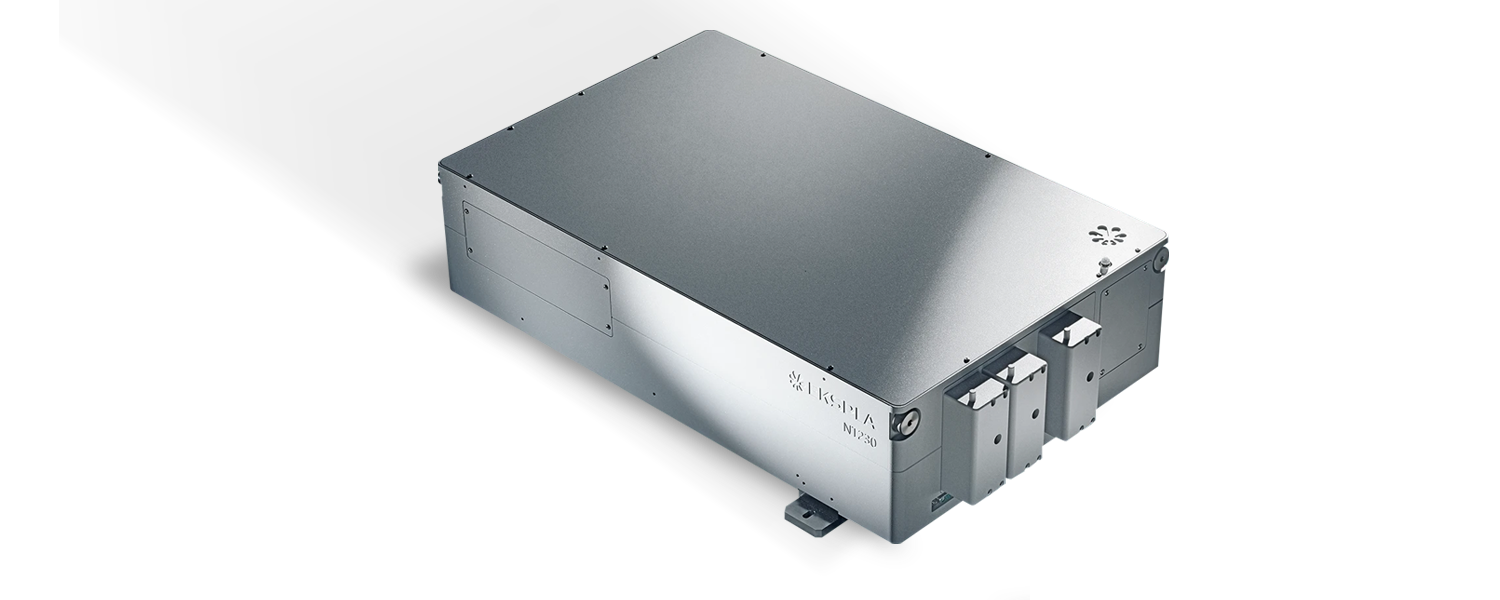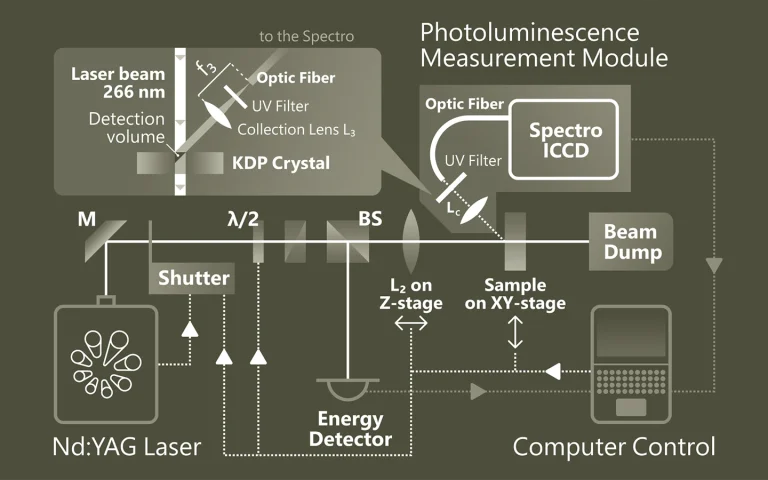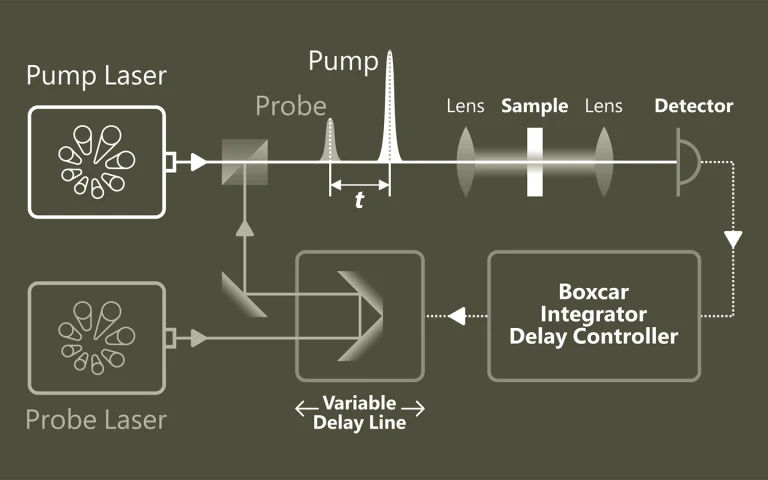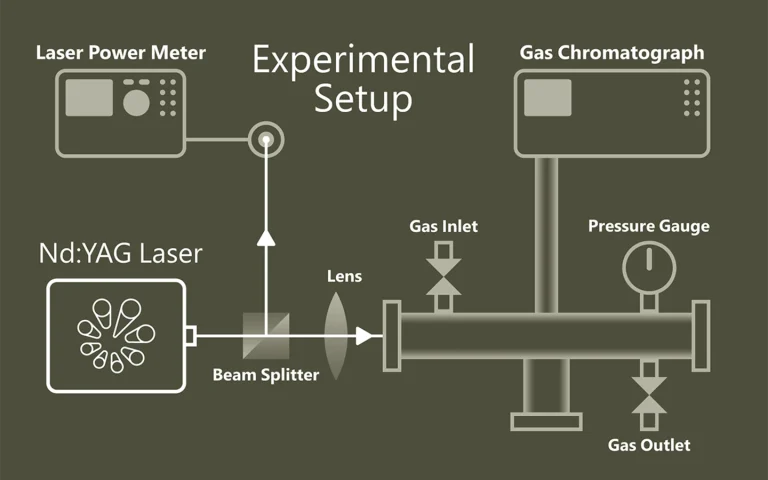NT230
Abstimmbarer Diodengepumpter Laser mit hoher Pulsenergie
Der NT230-Tunable-Laser bietet lückenloses, motorisiertes Wellenlängen-Tuning von 192 bis 2600 nm – aus nur einem Gehäuse. Mit 100 Hz Wiederholrate ist er vielseitig einsetzbar, z. B. für LIF, Photolyse, Photobiologie, Messtechnik und Fernerkundung.

Features
- Zwei Jahre Gewährleistung
- Integriert DPSS-Pumplaser und OPO in einem Gehäuse
- Motorisiertes, lückenloses Wellenlängen-Tuning von 192 bis 2600 nm*
- Bis zu 15 mJ Pulsenergie aus dem OPO
- Bis zu 100 Hz Pulswiederholrate
- Bis zu 2 mJ Ausgangspulsenergie im UV-Bereich
- Linienbreite < 5 cm⁻¹
- 2–5 ns Pulsdauer
- Elektromechanische Ausgangsverschlüsse
- 355 nm- 532nm- und 1064 nm-Laserausgänge
- Fernsteuerung über Tastenfeld oder PC
*Automatischer Wellenlängenscan ist programmierbar
Anwendungen
- Laserinduzierte
- Fluoreszenz
- Flash-Photolyse
- Photobiologie
- Fernerkundung
- Metrologie
- Nichtlineare Spektroskopie
- Photoakustische
- Bildgebung
Anwendungen

Emission, die Einblicke gibt
Die Photolumineszenz-Spektroskopie (PL) ist eine berührungslose Methode zur Untersuchung elektronischer und struktureller Eigenschaften von Materialien. Dabei wird das Material durch Licht angeregt und die emittierte Strahlung analysiert. Diese spektrale Information gibt Aufschluss über Bandlücken, Defekte, Dotierungen oder Quantenstruktur. PL ist besonders wertvoll für Halbleiter, Nanostrukturen und optoelektronische Materialien

Pumpen. Proben. Verstehen
Die Pump-Probe-Spektroskopie ermöglicht einen tiefen Einblick in ultraschnelle Prozesse auf atomarer und molekularer Ebene. Mithilfe von gepulsten Lasern lassen sich dynamische Veränderungen mit extrem hoher zeitlicher Auflösung verfolgen. Typische Anwendungen liegen in der Untersuchung von Ladungsträgerdynamik in Halbleitern, der Analyse von Elektronentransfer in chemischen Reaktionen sowie der Erforschung lichtinduzierter Phasenübergänge in Materialien.

Wenn Licht Moleküle trennt
Photolyse beschreibt die lichtinduzierte Spaltung chemischer Verbindungen und spielt eine zentrale Rolle in der Photosynthese durch Wasserspaltung. Die Laser-Flash-Photolyse nutzt kurze, intensive Laserpulse (ns–fs), um kurzlebige Zwischenprodukte wie Radikale oder angeregte Zustände zu erzeugen und deren zeitlich aufgelöste Absorption zu beobachten. Probe-Pulse erfassen Reaktionsverläufe. Der Einsatz von OPOs erweitert die Möglichkeiten spektroskopischer Untersuchungen deutlich.
Anwendungen
Wissenschafliche Veröffentlichungen
Electronic spectroscopy and nanocalorimetry of hydrated magnesium ions [Mg(H2O)n]+, n = 20–70: spontaneous formation of a hydrated electron?
T. Taxer, M. Ončák, E. Barwa, C. van der Linde, and M. K. Beyer, Faraday Discuss. 217, 584-600 (2019). DOI: 10.1039/C8FD00204E.
Hydrated singly charged magnesium ions [Mg(H2O)n]+ are thought to consist of an Mg2+ ion and a hydrated electron for n > 15. This idea is based on mass spectra, which exhibit a transition from [MgOH(H2O)n−1]+ to [Mg(H2O)n]+ around n = 15–22, black-body infrared radiative dissociation, and quantum chemical calculations. Here, we present photodissociation spectra of size-selected [Mg(H2O)n]+ in the range of n = 20–70 measured for photon energies of 1.0–5.0 eV. The spectra exhibit a broad absorption from 1.4 to 3.2 eV, with two local maxima around 1.7–1.8 eV and 2.1–2.5 eV, depending on cluster size. The spectra shift slowly from n = 20 to n = 50, but no significant change is observed for n = 50–70. Quantum chemical modeling of the spectra yields several candidates for the observed absorptions, including five- and six-fold coordinated Mg2+ with a hydrated electron in its immediate vicinity, as well as a solvent-separated Mg2+/e− pair. The photochemical behavior resembles that of the hydrated electron, with barrierless interconversion into the ground state following the excitation.
Luminescence spectroscopy of oxazine dye cations isolated in vacuo
C. Kjær, and S. B. Nielsen, Phys. Chem. Chem. Phys. 21, 4600-4605 (2019). DOI: 10.1039/C8CP07340F.
Here we report gas-phase action and luminescence spectra of cationic dyes derived from oxazine: cresyl violet (CV+), oxazine 170 (Ox-170+), nile blue (NB+), darrow red (DR+), oxazine 1 (Ox-1+), oxazine 4 (Ox-4+), and brilliant cresyl blue (BCB+). The first four have a benzofused structure, which results in asymmetric charge distributions along the long axis. The positive charge is also asymmetrically distributed in BCB+ while Ox-1+ and Ox-4+ are symmetric. As the ions are isolated in vacuo, there are no interactions with solvent molecules or counter ions, and the effect of chemical modifications is therefore more easily revealed than from solution-phase experiments. The transition energy decreases in the order: DR+ > CV+ > Ox-4+ > Ox-170+ > BCB+ > Ox-1+ > NB+, and the fluorescence from BCB+ is less than from the others. We discuss the results based on electron delocalisation, degree of charge-transfer character, rigidity of the chromophore structure, and substituents.
Photodissociation of Sodium Iodide Clusters Doped with Small Hydrocarbons
C. Kjær, and S. B. Nielsen, Phys. Chem. Chem. Phys. 21, 4600-4605 (2019). DOI: 10.1039/C8CP07340F.
Marine aerosols consist of a variety of compounds and play an important role in many atmospheric processes. In the present study, sodium iodide clusters with their simple isotope pattern serve as model systems for laboratory studies to investigate the role of iodide in the photochemical processing of sea-salt aerosols. Salt clusters doped with camphor, formate and pyruvate are studied in a Fourier transform ion cyclotron resonance mass spectrometer (FT-ICR MS) coupled to a tunable laser system in both UV and IR range. The analysis is supported by ab initio calculations of absorption spectra and energetics of dissociative channels. We provide quantitative analysis of IRMPD measurements by reconstructing one-photon spectra and comparing them with the calculated ones. While neutral camphor is adsorbed on the cluster surface, the formate and pyruvate ions replace an iodide ion. The photodissociation spectra revealed several wavelength-specific fragmentation pathways, including the carbon dioxide radical anion formed by photolysis of pyruvate. Camphor and pyruvate doped clusters absorb in the spectral region above 290 nm, which is relevant for tropospheric photochemistry, leading to internal conversion followed by intramolecular vibrational redistribution, which leads to decomposition of the cluster. Potential photodissociation products of pyruvate in the actinic region may be formed with a cross section of <2×10−20 cm2, determined by the experimental noise level.
